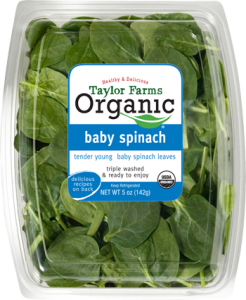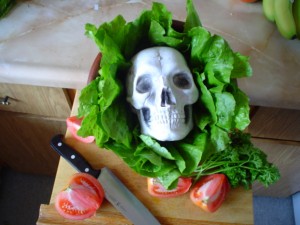From Abu Dhabi to Akron, Ohio, people are worried about the safety of leafy greens – spinach, lettuce, rocket, whatever.
Gulf News reports that locally grown fresh salad vegetables in the UAE are, according to academics, contaminated by dangerous bacteria because of unhygienic farm practices and improper food handling from the farm to the table.
They also warned nearly 43 per cent of water wells in the country are contaminated with bacteria that exceed the standard level of safe  consumption, even for irrigation of crops.
consumption, even for irrigation of crops.
“If there is a serious epidemic or outbreak of life-threatening gastrointestinal disease we will know the source, namely, the contaminated salad greens we are eating nearly every day,” said Dr Dennis J. Russell, professor of biology, department of biology, chemistry and environmental science at the American University of Sharjah.
Research over the past five years showed the presence of persistent coliform and E. coli contamination sequestered within the leaves of the locally grown popular fresh salad vegetable knows locally as jarjeer (ccientific name rocket/rocca) and other salad greens, Dr Russells told Gulf News.
‘All of the samples of jarjeer were found contaminated with E. coli and 100 per cent of the latest samples were also contaminated with large amounts of Salmonella. Tests of other locally grown greens show they too are contaminated with these bacteria, although to a lesser extent,” Dr Russell said.
Michael Doyle, director of the Center for Food Safety at the University of Georgia told the Daily Herald that a recent study released by the Centers for Disease Control and Prevention fingered produce as the leading cause of food poisoning in the U.S.
Doyle said the more cracks and grooves on the skin of a fruit or vegetable, the more easily bacteria can hide. Melons also have a neutral pH, so they offer a perfect growing environment for bacteria.
The problem of contaminated melons is often made worse by grocery stores that sell cut pieces, but often don’t store them in a cold enough  environment.
environment.
Doyle recalls walking into an upscale grocery store in South Carolina one summer, where a metal tank with ice in the bottom was filled with containers of cut melon. The bottom inch of the containers was inside the ice, leaving the majority of the melon in an environment warm enough for bacteria to multiply rapidly.
In the CDC’s new study, however, leafy greens like lettuce and spinach were revealed as the worst culprits for food poisoning in the study period, between 1998 and 2008.
Salad greens marked “washed and ready to eat” or “triple-washed” remain an area of debate among food safety experts.
Some experts contend that the triple-washing with chlorine that takes place during processing is enough to kill what bacteria can be killed, and advise against washing bagged greens because the risk of cross-contamination in the home kitchen is a greater concern.
Doyle says not to buy bagged greens at all. He advises buying whole heads of lettuce or greens, removing the outer surface layers where bacteria is most likely to be present, and then washing the greens under cold running water.
Doyle has conducted studies that show the cutting and bagging of lettuce in processing plants can actually trap bacteria inside the lettuce leaves, meaning that no amount of scrubbing or washing will ever get rid of the germs. If greens are cut before they are washed — as they commonly are during processing — the bacteria become internalized by the leaves, trapping the germs inside the produce.
As risky as bagged greens can be, Doyle said an even greater concern should be the consumption of raw sprouts like bean and alfalfa.
He believes the only reason they weren’t first on the list of illness-causing produce in the CDC study is that folks just don’t eat nearly as many of them as they do items like lettuce, tomatoes or melon.
He said sprouts, due to their high levels of contamination, should never be consumed raw.
 Amy’s Kitchen, Inc. is voluntarily recalling approximately 73,897 cases of select code dates and manufacturing codes of products.
Amy’s Kitchen, Inc. is voluntarily recalling approximately 73,897 cases of select code dates and manufacturing codes of products.














